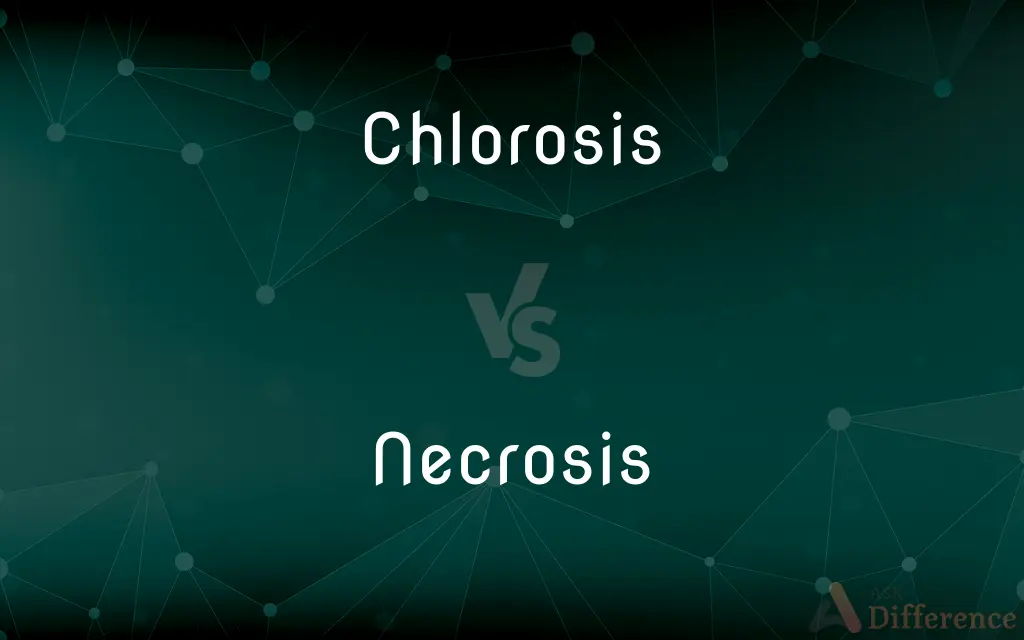Chlorosis vs. Necrosis — What's the Difference?
By Tayyaba Rehman & Urooj Arif — Updated on April 18, 2024
Chlorosis involves the yellowing of plant leaves due to insufficient chlorophyll, often caused by nutrient deficiencies, while necrosis refers to the death of plant tissue due to factors like disease, injury, or harsh environmental conditions.

Difference Between Chlorosis and Necrosis
Table of Contents
ADVERTISEMENT
Key Differences
Chlorosis is characterized by the yellowing of leaf tissue due to a lack of chlorophyll, which is essential for photosynthesis and gives leaves their green color. In contrast, necrosis involves the browning and dying of plant tissue, which can result from various stresses including infections, toxins, or physical damage.
Chlorosis often indicates problems such as nutrient deficiencies, particularly of iron, magnesium, or zinc, which are crucial for chlorophyll production. On the other hand, necrosis can be triggered by more severe conditions, including fungal infections, bacterial invasions, or environmental extremes like frost or drought.
While chlorosis may be reversible if the underlying issue is addressed, such as adjusting soil pH or providing missing nutrients, necrosis signifies permanent damage where affected tissues cannot recover. Conversely, management strategies for necrosis focus on preventing spread or further damage, such as by removing affected parts or applying fungicides.
Chlorosis and necrosis can sometimes appear in the same plants, where initial chlorosis might lead to necrosis if left unmanaged, indicating a progression from a potentially manageable condition to a more fatal one.
Comparison Chart
Definition
Yellowing of leaves due to chlorophyll deficiency.
Death of plant tissue.
ADVERTISEMENT
Causes
Nutrient deficiencies, poor soil pH.
Disease, injury, harsh environmental conditions.
Symptoms
Yellow leaves, may remain intact.
Brown or black tissue, often collapses.
Reversibility
Often reversible with proper treatment.
Generally irreversible.
Management
Nutrient supplementation, pH adjustment.
Removal of affected parts, use of fungicides.
Compare with Definitions
Chlorosis
Incomplete chlorophyll formation leading to yellow leaves.
The garden's rose showed signs of chlorosis due to iron deficiency.
Necrosis
The death of plant cells and tissues.
Necrosis on the leaves was caused by a severe fungal infection.
Chlorosis
Often caused by nutrient imbalances.
Chlorosis in her citrus trees was corrected with magnesium supplements.
Necrosis
Often results from environmental stress.
The recent drought led to necrosis in young saplings.
Chlorosis
Reversible if addressed early.
Chlorosis in the vineyard was reversed after adjusting the soil nutrients.
Necrosis
Symptoms include dark, dried, or crumbly tissue.
Necrosis caused the outer edges of the leaves to turn black and crumble away.
Chlorosis
Manifests as yellowing between leaf veins.
Chlorosis was evident in the new growth, highlighting the veins in stark green against yellow.
Necrosis
Typically involves cutting away dead tissue.
Pruning the necrotic branches helped prevent further spread of decay.
Chlorosis
Can indicate poor soil conditions.
The widespread chlorosis suggested that the soil pH was too alkaline.
Necrosis
Indicative of severe health issues in plants.
The widespread necrosis in the crop was the final blow after the flood.
Chlorosis
In botany, chlorosis is a condition in which leaves produce insufficient chlorophyll. As chlorophyll is responsible for the green color of leaves, chlorotic leaves are pale, yellow, or yellow-white.
Necrosis
Necrosis (from Ancient Greek νέκρωσις, nékrōsis, "death") is a form of cell injury which results in the premature death of cells in living tissue by autolysis. Necrosis is caused by factors external to the cell or tissue, such as infection, or trauma which result in the unregulated digestion of cell components.
Chlorosis
The yellowing or whitening of normally green plant tissue because of a decreased amount of chlorophyll, often as a result of disease or nutrient deficiency.
Necrosis
Death of cells through injury or disease, especially in a localized area of a tissue or organ.
Chlorosis
An iron-deficiency anemia, primarily of young women, characterized by a greenish-yellow discoloration of the skin. Also called greensickness.
Necrosis
(pathology) The localized death of cells or tissues through injury, disease, or the interruption of blood supply.
Chlorosis
An anaemia, due to deficiency of iron, characterized by a yellow-green colouration of the skin; greensickness.
Necrosis
The pathologic death of part of a tissue due to irreversible damage. Contrast to necrobiosis, which is a normal death of cells in a tissue. Formerly, applied primarily to death of bone tissue.
Chlorosis
A yellowing of plant tissue due to loss or absence of chlorophyll.
Necrosis
A disease of trees, in which the branches gradually dry up from the bark to the center.
Chlorosis
The green sickness; an anæmic disease of young women, characterized by a greenish or grayish yellow hue of the skin, weakness, palpitation, etc.
Necrosis
The localized death of living cells (as from infection or the interruption of blood supply)
Chlorosis
A disease in plants, causing the flowers to turn green or the leaves to lose their normal green color.
Chlorosis
Iron deficiency anemia in young women; characterized by weakness and menstrual disturbances and a green color to the skin
Common Curiosities
Can chlorosis lead to necrosis?
Yes, if chlorosis is severe and left untreated, it can progress to necrosis, resulting in tissue death.
What is chlorosis in plants?
Chlorosis is a condition where plant leaves develop yellow patches due to insufficient chlorophyll.
Is necrosis reversible in plants?
No, once plant tissue becomes necrotic, it cannot be revived, but further damage can be minimized.
What are the symptoms of necrosis in plants?
Symptoms include browning or blackening of tissue, which may become dry and crumble.
What environmental conditions can cause necrosis?
Extreme temperatures, excessive water, and physical damage can all lead to necrosis.
What causes plant necrosis?
Necrosis in plants is caused by factors like infections, physical injury, or extreme environmental conditions.
Can necrosis spread in plants?
Yes, necrosis can spread, especially if caused by infectious agents like fungi or bacteria.
How does nutrient deficiency lead to chlorosis?
Nutrient deficiencies limit the availability of essential components for chlorophyll production, leading to chlorosis.
How can you treat chlorosis in plants?
Treating chlorosis involves correcting nutrient deficiencies and adjusting soil pH to optimal levels.
What plants are most susceptible to chlorosis?
Plants in poorly drained or incorrectly pH-balanced soils, and those lacking essential nutrients, are susceptible.
Is chlorosis a disease?
Chlorosis itself is not a disease but a symptom of underlying issues such as nutrient deficiencies or poor soil conditions.
How is chlorosis diagnosed?
Chlorosis is diagnosed through visual examination and soil or tissue tests to identify nutrient deficiencies.
What are early signs of chlorosis?
Early signs include pale green leaves and yellowing between veins.
What is the difference between chlorosis and leaf scorch?
Chlorosis is due to lack of chlorophyll causing yellowing, whereas leaf scorch typically results from external environmental stresses causing browning and drying of leaf edges.
Can pruning help control necrosis?
Yes, pruning affected areas can help control the spread of necrosis and improve plant health.
Share Your Discovery

Previous Comparison
Stipend vs. Salary
Next Comparison
Foldover vs. CalzoneAuthor Spotlight
Written by
Tayyaba RehmanTayyaba Rehman is a distinguished writer, currently serving as a primary contributor to askdifference.com. As a researcher in semantics and etymology, Tayyaba's passion for the complexity of languages and their distinctions has found a perfect home on the platform. Tayyaba delves into the intricacies of language, distinguishing between commonly confused words and phrases, thereby providing clarity for readers worldwide.
Co-written by
Urooj ArifUrooj is a skilled content writer at Ask Difference, known for her exceptional ability to simplify complex topics into engaging and informative content. With a passion for research and a flair for clear, concise writing, she consistently delivers articles that resonate with our diverse audience.














































